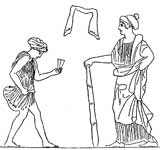.
Der Tanz im antiken Griechenland
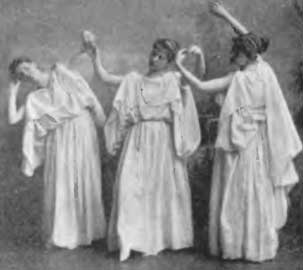
|
From the Heliconian Muses let us begin to sing and, when they have washed their tender bodies in |
Μουσάων Ἑλικωνιάδων ἀρχώμεθ' ἀείδειν, |
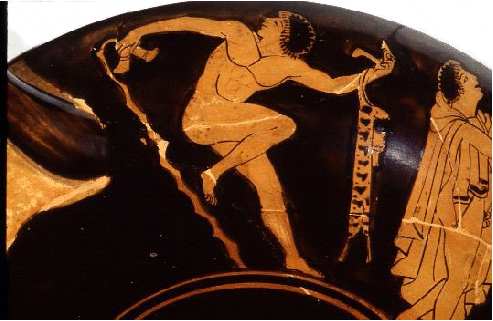
Dancer with krotala, flute case, and walking stick, Attic red figure kylix, ca. 480 BC
Dance is mentioned in the Homeric poems: the suitors of Penelope delight themselves with music and dancing. Odysseus is entertained at the court of Alcinous with the exhibitions of very skillful dancers.
Plutarch describes the dance of Theseus and his fellow Athenian youths who had just escaped from the Minotaur on Crete (Plutarch Theseus).
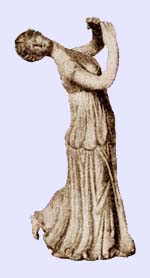
Dancing girl, Terra cotta , c. 350 BC (British Museum.)
Plato, the great moralist, says that all dancing should be based on religion like the Egyptians as he claims.
Timon of Phlius around 260 BC was a dancer but also a philosopher and poet.
Another interesting and funny story is that of famous generals who were often asked to perform dances in celebration of military victories just like our generals today would be asked to give speeches. A similar strange story about music is that whereas the Romans used the trumpet going out to fight the Spartans marched into battle with the music of the flute and the accompaniment of lyre and harp.(Pausanias Guide to Greece)
The religious aspects of the Panathenaic festival were coupled with parades, music, dancing, poetry and athletic competitions. Valuable prizes were awarded to the winners.
There was not only a war between Persians and Greeks but also a exchange of culture as described by Nima Kiann, Founder & Artistic Director of Les Ballets Persans:
A Greek historian wrote about the popular and talented female dancer, Zenon from Crete, who was the court dancer of Artaxerxιs II and “the apple of the King’s eye”.
At the marriage of Alexander the Great with "Roxana" in Susa, which continued in five days, Alexander was amused by Greek musicians, singers and dancers who were engaged at the Persian Imperial Court.

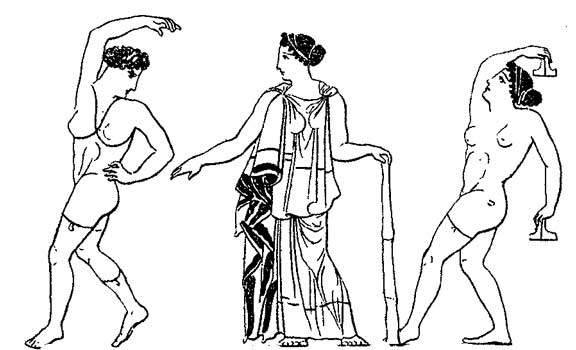
Dance Lesson, Vase Painting, c. 450 BC, British Museum
Types of dances
The dances of the ancient times are characterized as dances of war or dances of peace. The latter are distinguished in dances of theater, religious and worshiping dances, martial dances, symposia dances, mourning dances, etc. Each type of presentation - tragedy, comedy, and satirical play - had its characteristic dances, some staid and solemn, some featuring lewd miming with phallic props. Dance in the military was important but I assume that today it is less important :-).Dances cited in the ancient texts are the following:
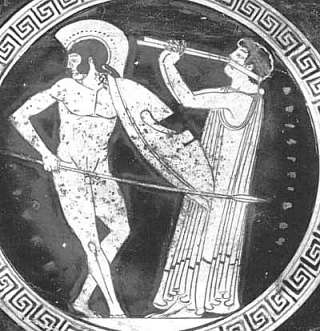
A Pyrrhic dance (Πυρρίχιος), scence from a Kylix cup, c. 490 BC, Eucharides Painter, Louvre Paris.

Dance in armour, Vatican Museum
A general name for dance in armor that is known generally as "Pyrrhiche" (Pyrrhic dance). These martial dances are part of the basic military education in both Athens and Sparta accompanied by the sound of a flute. The four divisions were, the podism or footing a quick motion such as might be required for overtaking the enemy (or for fleeing from him) the Xiphism, or sham fight; the Kosmos with very high leaping or vaulting a training for the jumping of ditches or walls and the Tetracomos a square figure with slow majestic measure (L. Grove ). There are variations armed dances and different origins:
In Athens, at the Panathenaia festival pyrrhic dance contests. Dance associated with Athena who was considered the inventor of the dance.
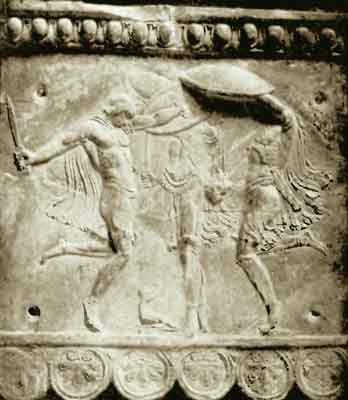
According to Cretan mythology the Kouretes protected the infant Zeus from Kronos making noise with their shields and assumed to be the inventors of dance in armour. One of these Kouretes, a chorleader, was Pyrrhikos. In Creta there was an associated Kouretes armed dance with swords.
In Euboea, armed dance in honor for Artemis Amarysia
One other possible mythological origin of the name: Pyrrhus (known also as Neoptolemos) (a son of Achilles).
Other probably dance variations: Prylis (πρύλις), Telesias (τελεσιάς),...
|
1035. ... The Idæi Dactyli find out Iron in mount Ida in Crete, and work it into armour and iron tools, and thereby give a beginning to the trades of smiths and armourers in Europe; and by singing and dancing in their armour, and keeping time by striking upon one another's armour with their swords, they bring in Music and Poetry; and at the same time they nurse up the Cretan Jupiter in a cave of the same mountain, dancing about him in their armour. Sir Isaac Newton |
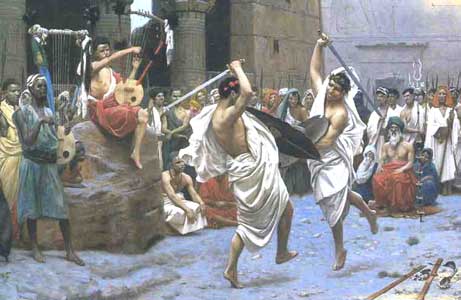
Pyrrhic Dance, part of a painting of Jean-Léon Gérôme
The Pyrrhic dance was performed in different ways at various times and in various countries, for it was by no means confined to the Doric states. Plato describes it as representing by rapid movements of the body the way in which missiles and blows from weapons were avoided, and also the mode in which the enemy were attacked. In the non-Doric states it was probably not practised as a training for war, but only as a mimetic dance: thus we read of its being danced by women to entertain a company (Xenophon Anabasis). William Smith, A Dictionary of Greek and Roman Antiquities, John Murray, London, 1875.
A Review of a Book about Pyrrhic Dance
There are versions of solo dancing, so-called monomachia or skiamachia, like a fight against an imaginary opponent (which somebody nicely described as an action like shadow-boxing). The clothes of the dancers are described to be red colored or having red points simulating blood-stains as the Spartans used probably to make the dance more “realistic”. This could explain also another name of these dances as “red dances”.
Gymnopaedia (Γυμνοπαιδιά) the main dance of the Lacedaemonians performed annually at the agora in Sparta. “Under the name of anapale, nude boys, moving gracefully to the music of flute or lyre, displayed postures and movements used in wrestling and boxing. Elisabeth A. Hanley
Dancing by L. Grove and others:
The Gymnopaidia mentioned by Pausanias go back to the 29th Olympiad. They were as much processions as dances. The leaders were called Thyreatics in memory of the victory of Thyrea, and the carried wreaths of palms.
Verses accompanied the dance:
The old men began:
We once were yound and gay as you
valiant, bold and active too.
The young men responded:
This now our turn, and you shall see
You've never deserved it more than we.
The boys chimed in:
The day shall come when we shall show
Feats that surpass all you can do.
Dance or in Greek Choros. The mythical (choros), built by Daidalus for Ariadne (Iliad, 18.590), still remains a mysterious and ambiguous term for concerned scholars.It either signified the choral dance or the magical space where the dance was performed: namely the dancing floor. The ancient scholars interpreted choros as a place (topos), complete with columns and statues arranged in a circle. Recently discovered circular structures at Knossos were somehow related to Daidalic choros In earlier texts, choros denoted dance without the indication of a dancing floor. The dance existed in itself and stayed as a temporal phenomenon. The meaning of the word is still on enigmatic grounds and its importance lies in this ambiguity, Ömür Harmansah Archaic Age and the Metamorphoses of Greek Culture
Next on that shield, the celebrated lame god made
an elaborately crafted dancing floor, like the one
Daedalus created long ago in spacious Cnossus,
for Ariadne with the lovely hair. On that floor,
young men and women whose bride price would require
many cattle were dancing, holding onto one another
by the wrists. The girls wore fine linen dresses,
the men lightly rubbed with oil wore woven tunics.
On their heads the girls had lovely flower garlands.
The men were carrying golden daggers on silver straps.
They turned with such a graceful ease on skilful feet,
just as a potter sits with a wheel between his hands,
testing it, to make sure that it runs smoothly.
Then they would line up and run towards each other.
A large crowd stood around, enjoying the dancing magic,
as in the middle two acrobats led on the dance,
springing, and whirling, and tumbling.
Homer, (The Shield of Achilles) Iliad Book 18
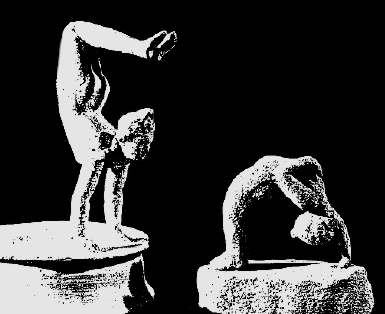

Crane Dance (Geranos) of Theseus and the Athenian youths (“anamiktos”, young men and women mixed ) on their escape from Crete from the François volute krater, potted by Ergotimos, painted by Kleitias,Archaic Ancient Greek Art, ca. 570 BC, Museo Archeologico, Florence

Geranos (Γέρανος) (crane dance) was danced in Delos. According to Plutarch, Theseus after having killed the Minotaur in the Labyrinth of Knossos, on his way back to Athens, he stopped at Delos. There, he offered a sacrifice to the goddess Aphrodite and he danced around the altar. This dance included serpentine movements, imitating the movements of Theseus inside the Labyrinth. The dance is mentioned by Homer in the Iliad. Some experts say that Theseus danced the Geranos in Crete and not Delos.
Ierakio (Ιεράκειο) a women's dance danced in festivals in honour of the goddess Hera.
Epilinios (Επιλήνιος) a dionysiac dance danced on top of the vats while treading the grapes with their feet..
Emelia ( or Emmeleia )(Εμμέλεια) the dance of tragedy, enhancing the events enacted on the stage. .
Kordax (or Cordax) (Κόρδαξ) was the dance of the comedy was looked down on, and in general regarded as unworthy of serious men. .

Dancing Faun (A roman version of the Satyr), probably a scene from the sikkinis dance
Sikkinis (Σίκκινις) was the dance of the satirical drama, imitating the movements of cats and danced by Satyrs..
Imeneos (Υμέναιος) the dance of the marriage. It was danced by the bride with her mother and friends. It was quick with a lot of twists and turns.
Hormos (Ορμος ή Αλυσίδα) is according to Lucian a common dance of the young men and women who dance one by the other forming a chain. The leader is a young man who shows his dancing and martial abilities through his movements. A young woman follows him providing an example of solemnity and decency to all other women dancers. (considered to be an invention of Lycurgus)
Iporchima (or Hyporcheme) (Υπόρχημα) a combination of dance and pantomime, singing and music from Crete. It was danced by boys and girls together singing choric poems. Also a dance in Sparta

Image from a Corinthian Aryballos from the Apollo Temple in Corinth, first quarter of the sixth century BC. Text includes the names of Polyterpos and Pyrrhias
Bibasis, a spartan dance, "The dance consisted in springing rapidly from the ground, and striking the feet behind...The number of successful strokes was counted, and the most skilful received prizes. We are told by a verse which has been preserved by Pollux (iv.102), that a Laconian girl had danced the bibasis a thousand times, which was more than had ever been done before " William Smith , A Dictionary of Greek and Roman Antiquities, John Murray, London, 1875.
Dancing by L. Grove and others:
Cheironomia the art of speaking by means of hand gestures must be considered as part of the study of classic dance. This branch of art was essential to the dancer of the theater. Athenaeus writes that Telestes, a dancer in the theater of Aeschyles, was so skilled in Cheironomia that he represented in dance the "Seven before Thebes"
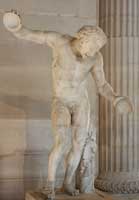

Dionysiac Dance
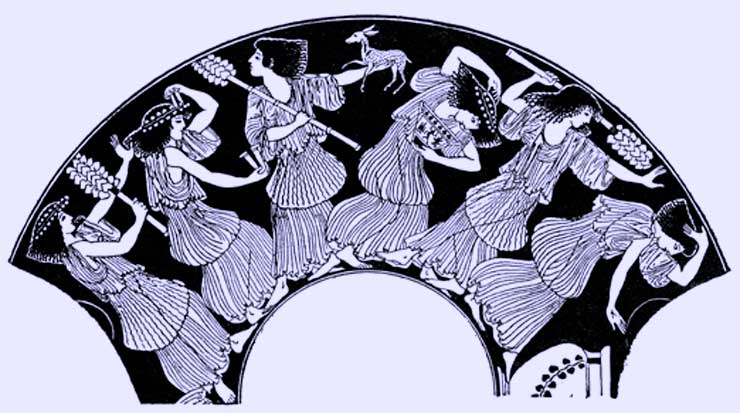
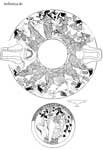
Dionysus and Maenads, Berlin, Antikensammlung, F2290, Attributed to Hieron Potter
Dance Lesson
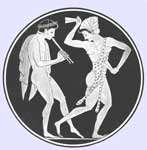
Diaulos Player and Dancing woman, Epiktetos
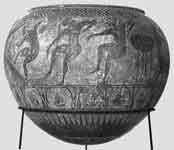
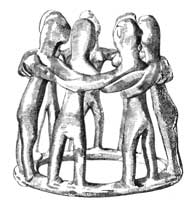
Sculpture from Olympia
NAMA 1959 Running/Dancing youth
The Ancient Dancer in the Modern World: Responses to Greek and Roman Dance, Fiona MacIntosh
| Ancient Greece
Science, Technology , Medicine , Warfare, , Biographies , Life , Cities/Places/Maps , Arts , Literature , Philosophy ,Olympics, Mythology , History , Images Medieval Greece / Byzantine Empire Science, Technology, Arts, , Warfare , Literature, Biographies, Icons, History Modern Greece Cities, Islands, Regions, Fauna/Flora ,Biographies , History , Warfare, Science/Technology, Literature, Music , Arts , Film/Actors , Sport , Fashion --- |

